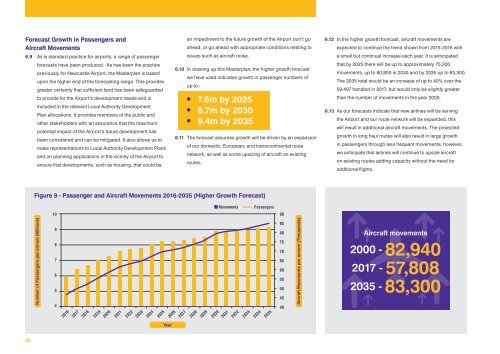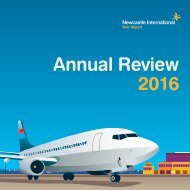Airport Masterplan 2035 LOW RES
You also want an ePaper? Increase the reach of your titles
YUMPU automatically turns print PDFs into web optimized ePapers that Google loves.
<strong>Masterplan</strong> <strong>2035</strong><br />
Forecast Growth in Passengers and<br />
Aircraft Movements<br />
6.9 As is standard practice for airports, a range of passenger<br />
forecasts have been produced. As has been the practice<br />
previously for Newcastle <strong>Airport</strong>, the <strong>Masterplan</strong> is based<br />
upon the higher end of the forecasting range. This provides<br />
greater certainty that sufficient land has been safeguarded<br />
to provide for the <strong>Airport</strong>’s development needs and is<br />
included in the relevant Local Authority Development<br />
Plan allocations. It provides members of the public and<br />
other stakeholders with an assurance that the maximum<br />
potential impact of the <strong>Airport</strong>’s future development has<br />
been considered and can be mitigated. It also allows us to<br />
make representations to Local Authority Development Plans<br />
and on planning applications in the vicinity of the <strong>Airport</strong> to<br />
ensure that developments, such as housing, that could be<br />
an impediment to the future growth of the <strong>Airport</strong> don’t go<br />
ahead, or go ahead with appropriate conditions relating to<br />
issues such as aircraft noise.<br />
6.10 In drawing up this <strong>Masterplan</strong>, the higher growth forecast<br />
we have used indicates growth in passenger numbers of<br />
up to:-<br />
l 7.6m by 2025<br />
l 8.7m by 2030<br />
l 9.4m by <strong>2035</strong><br />
6.11 The forecast assumes growth will be driven by an expansion<br />
of our domestic, European, and transcontinental route<br />
network, as well as some upsizing of aircraft on existing<br />
routes.<br />
6.12 In the higher growth forecast, aircraft movements are<br />
expected to continue the trend shown from 2015-2016 with<br />
a small but continual increase each year. It is anticipated<br />
that by 2025 there will be up to approximately 75,200<br />
movements, up to 80,800 in 2030 and by <strong>2035</strong> up to 83,300.<br />
The <strong>2035</strong> total would be an increase of up to 40% over the<br />
59,407 handled in 2017, but would only be slightly greater<br />
than the number of movements in the year 2000.<br />
6.13 As our forecasts indicate that new airlines will be serving<br />
the <strong>Airport</strong> and our route network will be expanded, this<br />
will result in additional aircraft movements. The projected<br />
growth in long haul routes will also result in large growth<br />
in passengers through less frequent movements, however,<br />
we anticipate that airlines will continue to upsize aircraft<br />
on existing routes adding capacity without the need for<br />
additional flights.<br />
Cargo<br />
6.14 Although the <strong>Airport</strong> is currently not a major hub for air flown<br />
cargo, our operation is larger than most other UK airports of<br />
a similar size in terms of passenger numbers, aside from the<br />
major cargo hub at East Midlands <strong>Airport</strong>. However it is an<br />
area of the <strong>Airport</strong>’s operation where we have identified the<br />
demand and physical capacity for growth.<br />
6.15 The volume of cargo passing through the <strong>Airport</strong> over recent<br />
years has fluctuated with demand and wider economic<br />
activity. Over 9,500 tons of cargo was flown in 2016, broadly<br />
a 12% increase from the previous year. The value of these<br />
exports was over £350m.<br />
6.16 The capacity of belly holds on wide body aircraft such as<br />
the Emirates Boeing 777, and the market opportunities<br />
trans-continental routes open up for exporters, shows the<br />
growth in cargo movements which could be brought about<br />
Independent Economic Review, and the Strategic Economic<br />
Plans for the North East and Tees Valley LEPs all identify<br />
the growth potential for these key high value sectors, and<br />
strategy interventions to facilitate this. They also identify the<br />
need to support an increase in exports. This in turn could<br />
lead to a larger market for air flown cargo.<br />
6.19 In addition, in a globalised and digitised economy where<br />
the demand for the movement of some goods direct to<br />
homes now often skips the traditional high street, there is an<br />
apparent growing demand for the development of last mile<br />
freight facilities, where goods can be transferred between<br />
modes. Land south of the runway is able to accommodate<br />
such development.<br />
6.20 Globally the market for air cargo is expected to continue to<br />
grow over the <strong>Masterplan</strong> period. Boeing has forecast that<br />
world air cargo traffic will grow on average 4.2% per year<br />
from 2015-<strong>2035</strong>, and as such they and other manufacturers<br />
have a healthy order backlog for freighter aircraft 14 .<br />
6.21 In addition to those factors, we anticipate that there will be<br />
growth in long haul services utilising wide body aircraft,<br />
which will add significant capacity for goods to be carried in<br />
their belly holds.<br />
by more direct long haul routes. Indeed, this is identified<br />
Figure 9 - Passenger and Aircraft Movements 2016-<strong>2035</strong> (Higher Growth Forecast)<br />
Number of Passengers per annum (Millions)<br />
10<br />
9<br />
8<br />
7<br />
6<br />
5<br />
4<br />
2016<br />
2017<br />
2018<br />
Year<br />
Movements<br />
Passengers<br />
2019<br />
2020<br />
2021<br />
2022<br />
2023<br />
2024<br />
2025<br />
2026<br />
2027<br />
2028<br />
2029<br />
2030<br />
2031<br />
2032<br />
2033<br />
2034<br />
<strong>2035</strong><br />
90<br />
85<br />
80<br />
75<br />
70<br />
65<br />
60<br />
55<br />
50<br />
45<br />
40<br />
Aircraft Movements per annum (Thousands)<br />
Aircraft movements<br />
2000 - 82,940<br />
2017 - 57,808<br />
<strong>2035</strong> - 83,300<br />
by Transport for the North as the means by which northern<br />
airports should grow their cargo services.<br />
6.17 The <strong>Airport</strong> does not have bespoke forecasts for the<br />
growth of air cargo to <strong>2035</strong>. It is highly dependent on<br />
locational decisions made by individual cargo companies<br />
and carriers, both at the <strong>Airport</strong> and in the wider market.<br />
However, there are a number of reasons why we expect our<br />
cargo operations to expand, both in terms of current and<br />
new operators.<br />
6.18 Goods shipped by air tend to be high value and/or their<br />
delivery is time critical, such as advanced manufactured<br />
products, parts in a global just-in-time delivery systems,<br />
pharmaceuticals, and fresh produce. The Government’s<br />
emerging Industrial Strategy, Transport for the North’s<br />
12<br />
http://www.boeing.com/resources/boeingdotcom/commercial/about-our-market/cargomarket-detail-wacf/download-report/assets/pdfs/wacf.pdf<br />
26<br />
27




